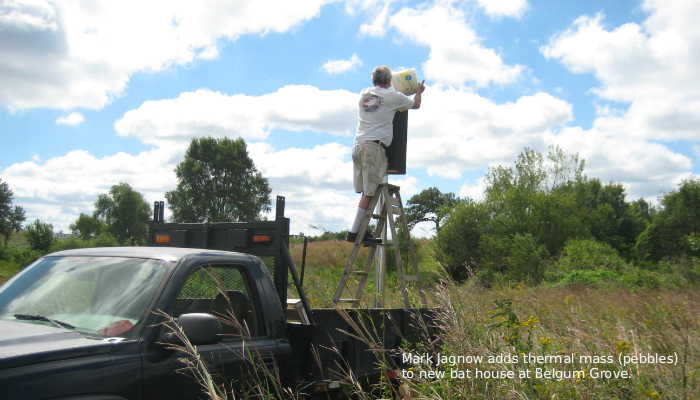A House Bat and a Bat House

By Lon Drake
More than a week ago, in late twilight, I stepped out into the yard to make sure someone had turned the stars on. They all seemed to be there, and on the way back indoors a bat apparently accompanied me, because a few minutes later I found one circling the dining room/living room. This happens about once a year because there are always bats hunting around our house in summer and I often go out to check on the stars. A butterfly net works well for me, and on about the sixth loop of our pirouette together, it was in the mesh.
A quick inspection showed that my guest had a pair of milk glands on her chest, the same as us primates (and in some Egyptian hieroglyphics a bat symbol can designate a nursing woman, because most other mammals have different arrangements). So I took the little girl back outside and flicked her up into the stars, where she vanished in a moment. She probably had a youngster waiting for Mom to come back from her hunting trip.
If it had been a little guy, I would have kept him as a resident for the night, because the next day the AmeriCorps NCCC team was going to be at Bur Oak Land Trust’s Belgum Grove, near Hills, and one of their activities was putting up a bat house. It would have been good to have a real bat on hand for show-and-tell. As it was, during our discussion that day it became pretty clear that some of their perceptions about bats had come from folklore and vampire movies, and were unnecessarily negative.
The new bat house we put up is a heavy clunky thing that indeed required a small team to install. It’s a second generation passive solar design and contains 50 pounds of pebbles. The pebbles heat by day and stay warm at night, which serves a nursery colony, well for the same reasons we keep newborn humans warm. Mark Jagnow and I finished the details last week and it is now ready for them to return from hibernation next spring.
Like many of our native critters, bats are in trouble, caused by loss of dead trees with flaps of loose bark for them to shelter under, humans exterminating them in attics, imported white nose disease, eating bugs contaminated with pesticides, loss of food supply – made up entirely of insects, etc. Consequently, conservationists across the country are doing what they can to upgrade summer habitat and protect winter hibernation places. If you want to build your own passive solar summer bat house, click here for blueprints: Lon Drake Bat House. This link also contains details on most favorable locations, installation, and management. Special thanks to Mark Madsen for building two of these bat houses. The other one will also be installed at Belgum Grove, later, when soils either dry out or freeze, providing better access. Both will also be available for show and tell at Family Day this Sunday. Come join us!


